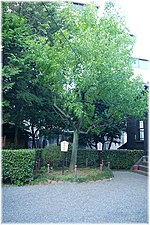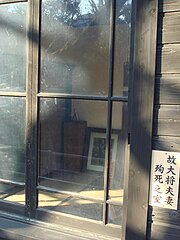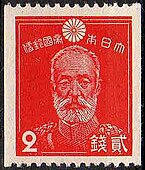| Count Nogi Maresuke | |
|---|---|
 Count Nogi Maresuke standing before his house in Nogizaka, Tokyo | |
| Nickname | Kiten, Count Nogi |
| Born | December 25, 1849 |
| Died | September 13, 1912 (aged 62) |
| Place of birth | Edo, Japan |
| Place of death | Tokyo, Japan |
| Allegiance |
|
| Service/branch |
|
| Years of service | 1871–1908 |
| Rank | General |
| Battles/wars | |
| Awards |
Grand Cordon of the Order of the Rising Sun with Paulownia Flowers Grand Cordon of the Order of the Golden Kite Grand Cordon of the Order of the Sacred Treasure Honorary Knight Grand Cross of the Order of the Bath (UK) Honorary Knight Grand Cross of the Royal Victorian Order (UK) |
Count Nogi Maresuke (乃木 希典), also known as Kiten, Count Nogi, (25 December 1849 – 13 September 1912) was a general in the Imperial Japanese Army and a governor of Taiwan. He was one of the commanders during the 1894 capture of Port Arthur from China, and the Port Arthur massacre[citation needed]. He was a prominent figure in the Russo-Japanese War of 1904-5, as commander of the forces which captured Port Arthur from the Russians.
He was a national hero in Imperial Japan as a model of feudal loyalty and self-sacrifice, ultimately to the point of suicide. In the Satsuma Rebellion, he lost a banner of the emperor in battle, for which he tried to atone with suicidal bravery in order to recapture it, until ordered to stop. In the Russo-Japanese War, he captured Port Arthur but he felt that he had lost too many of his soldiers, so requested permission to commit suicide, which the emperor refused. These two events, as well as his desire not to outlive his master (junshi), motivated his suicide on the day of the funeral of the Emperor Meiji. His example revitalized the Japanese tradition of ritual suicide.
Early life[]
Nogi was born as the son of a samurai at the Edo residence (present day Tokyo), of the Chōfu clan from Chōshū (present day Yamaguchi Prefecture). He was born on 11 November 1849, according to the old Japanese lunar calendar, or Christmas day, according to the new one. His childhood name was Mujin, literally "no one", to prevent evil spirits from coming to harm him. On turning 18, he was renamed Nogi Bunzō.[citation needed]
Early military career[]
In November 1869, by the order of the Nagato domain's lord, he enlisted in Fushimi Goshin Heisha (lit. the Fushimi Loyal Guard Barrack) to be trained in the French style for the domainal Army. After completing the training, he was reassigned to the Kawatō Barrack in Kyoto as an instructor, and then as Toyōra domain's Army trainer in charge of coastal defense troops.
In 1871, Nogi was commissioned as a major in the fledgling Imperial Japanese Army. Around this time, he renamed himself Maresuke taking a kanji from the name of his father. In 1875, he became the 14th Infantry Regiment's attaché. The next year (1876), Nogi was named as the Kumamoto regional troop's Staff Officer, and transferred to command the 1st Infantry Regiment, and for his service in the Satsuma Rebellion, against the forces of Saigō Takamori in Kyūshū, he was promoted to lieutenant colonel. In a fierce battle at that time, he lost the 14th Infantry Regiment’s regimental banner to the enemy, which was considered to be the property of the Emperor. Its loss was an extreme disgrace. Nogi considered this such a grave mistake that he listed it as one of the reasons for his later suicide.[1]
On 27 August 1876, Nogi married Shizuko, the fourth daughter of Satsuma samurai Yuji Sadano, who was then 20 years old. As Nogi was 28 years old, it was a very late marriage for that time, considering that the average age to marry was in the early 20s. On 28 August 1877, their first son Katsunori was born, and Nogi bought his first house at Nizakamachi, Tokyo. In 1878, he became a colonel. The next year, his second son, Yasunori, was born.[citation needed]
In 1887, Nogi went to Germany with Kawakami Soroku to study European military strategy and tactics.[2]
In 1894, during the First Sino-Japanese War, Nogi served as major general in command of the First Infantry Brigade, which penetrated the Chinese defenses and successfully occupied Port Arthur in only one day of combat. As such, he was a senior commander during the Port Arthur massacre. The following year, he was promoted to lieutenant general and assigned to the Second Infantry Brigade, tasked with the invasion of Taiwan. Nogi remained with the occupation forces in Taiwan until 1898. In 1899, he was recalled to Japan, and placed in command of the newly formed 11th Infantry Brigade, based in Kagawa.[citation needed]
Political career[]
After the war, he was elevated to danshaku (baron); and he was conferred with the Order of the Golden Kite, 1st class.[3]
Nogi was appointed as the third Japanese Governor-General of Taiwan from 14 October 1896 to February 1898. When moving to Taiwan, he moved his entire family, and during their time in Taiwan, his mother contracted malaria and died. This led Nogi to take measures to improve on the health care infrastructure of the island.
However, unlike many of his contemporary officers, Nogi expressed no interest in pursuing politics.[citation needed]
Russo-Japanese War[]

General Nogi standing in the center facing a captured Russian gun crew outside Port Arthur on 2 January 1905.
In 1904, Nogi was recalled to active service on the occasion of the Russo-Japanese War, and was promoted to army general in command of the Japanese Third Army, with an initial strength of approximately 90,000 men and assigned to the capture of the Russia port of Port Arthur on the southern tip of Liaodong Peninsula, Manchuria. Nogi's forces landed shortly after the Battle of Nanshan, in which his eldest son, serving with the Japanese Second Army, was killed.[4] Advancing slowly down the Liaodong Peninsula, Nogi encountered unexpectedly strong resistance, and far more fortifications than he had experienced ten years earlier against the Chinese.

General Nogi is seated in the center next to Russian general Anatoly Stessel after Russian forces surrendered at Port Arthur on 2 January 1905.
The attack against Port Arthur quickly turned into the lengthy Siege of Port Arthur, an engagement lasting from 1 August 1904 to 2 January 1905, costing the Japanese massive losses. Due to the mounting casualties and failure of Nogi to overcome Port Arthur's defenses, there was mounting pressure within the Japanese government and military to relieve him of command. However, in an unprecedented action, Emperor Meiji spoke out during the Supreme War Council meeting, defending Nogi and demanding that he be kept in command.[citation needed]
After the fall of Port Arthur, Nogi was regarded as a national hero. He led his 3rd Army against the Russian forces at the final Battle of Mukden, ending the land combat phase of operations of the war.[5]
British historian Richard Storry noted that Nogi imposed the best of the Japanese samurai tradition on the men under his command such that "...the conduct of the Japanese during the Russo-Japanese War towards both prisoners and Chinese civilians won the respect, and indeed admiration, of the world."[6]
Both Nogi's two sons, who were army lieutenants during the war, were killed in action. Though Nogi's elder son Katsunori (28 August 1879 - 27 May 1904) had been a sickly child, he had managed to enter the imperial military academy on his third try. He was hit in the abdomen at the Battle of Nanshan and died of blood loss while undergoing surgery at a field hospital. His second son Yasunori (16 December 1881 - 30 November 1904), a second lieutenant at Port Arthur, fell on a rocky slope, striking his head and dying instantly. Yasunori received a posthumous promotion to lieutenant, and was buried by his brother in the Aoyama cemetery.[7] At the end of the war, Nogi made a report directly to Emperor Meiji during a Gozen Kaigi. When explaining battles of the Siege of Port Arthur in detail, he broke down and wept, apologizing for the 56,000 lives lost in that campaign and asking to be allowed to kill himself in atonement. Emperor Meiji told him that suicide was unacceptable, as all responsibility for the war was due to imperial orders, and that Nogi must remain alive, at least as long as he himself lived.[8]

The Ziziphus jujuba which written in Monbusho chant lyrics.
It is located in General Nogi's mansion now.
Postwar career[]
After the war, Nogi was elevated to the title of count and awarded the Order of the Rising Sun with Paulownia Flowers, Grand Cordon, 1917.[3]
As head of the Peers' School from 1908–1912, he was the mentor of the young Hirohito, and was, perhaps, the most important influence on the life of the future emperor of Japan.[9]
Nogi spent most of his personal fortune on hospitals for wounded soldiers and on memorial monuments erected around the country in commemoration of those killed during the Russo-Japanese War. He also successful petitioned the Japanese government to erect a Russian-style memorial monument in Port Arthur to the Russian dead of that campaign.[citation needed]
Scouting[]
General Nogi is significant to Scouting in Japan, as in 1911, he went to England in attendance on Prince Higashifushimi Yorihito for the coronation of King George V. The General, as the "Defender of Port Arthur" was introduced to General Robert Baden-Powell, the "Defender of Mafeking", by Lord Kitchener, whose expression "Once a Scout, always a Scout" remains to this day.
Seppuku[]

Room in which Nogi Maresuke committed suicide with his wife.

House of Maresuke Nogi in Nogizaka.
Nogi and his wife committed suicide shortly after the Emperor Meiji's funeral cortege left the palace.[10] The ritual suicide was in accordance with the samurai practice of following one's master to death (junshi).[11] In his suicide letter, he said that he wished to expiate for his disgrace in Kyūshū, and for the thousands of casualties at Port Arthur. He also donated his body to medical science.[1]
All four members of the Nogi family are buried at Aoyama Cemetery in Tokyo. Under State Shinto, Nogi was revered as a kami and Nogi Shrine, a Shinto shrine in his honor, still exists on the site of his house in Nogizaka, Tokyo. His memory is also honored in other locations such as the Nogi Shrine in Kyoto.[12]
Legacy[]

Nogi Shrine in Nogizaka.
Nogi's seppuku immediately created a sensation and a controversy. Some writers claimed that it reflected Nogi’s disgust with the profligacy and decline in moral values of late Meiji Japan. Others pointed to Nogi's own suicide note, calling it an act of atonement for mistakes in his military career. In either case, Nogi's suicide marked the end of an era, and it had a profound impact on contemporary writers, such as Mori Ōgai and Natsume Sōseki. For the public, Nogi became a symbol of loyalty and sacrifice.
Man of letters[]
Nogi is noted in Japan as a man of letters also. His Kanshi poems (poems using Chinese characters) were especially popular among the Japanese during his time. Three of his Kanshi poems are famous.[13] Right after the Battle of Nanshan of 1904, in which he lost his eldest son, he wrote:
| 金州城外の作 | Written Outside the Walls of Jinzhou |
|---|---|
| 山川草木轉荒涼 十里風腥新戰場 |
Mountains and rivers, trees and grass, all turned desolate, Within ten li, the smell of bloodshed abounds in the new battlefield. |
After the battle of 203 Hill of 1904-05, in which he lost his second son, he lamented:
| 爾靈山 | Your Souls' Mountain |
|---|---|
| 爾靈山嶮豈難攀 男子功名期克艱 |
Can we say it was easy to climb 203 Hill? Was it not difficult because men sought their honor? |
After the end of the Russo-Japanese War, he wrote:
| 凱旋 | A Song of Triumph |
|---|---|
| 皇師百萬征強虜 野戰攻城屍作山 |
As a leader of the Imperial Army, I took a million soldiers in hostage. The battle resulted in a mountain of dead bodies. |
Honors[]
Information incorporated from the corresponding article in the Japanese Wikipedia
- 1878 - Upper fourth court rank (30 January)
- 1885 - Order of the Rising Sun, 3rd Class (7 April 1885)
- 1895 - Baron (20 August)
- 1895 - Order of the Rising Sun, 2nd Class and Order of the Golden Kite, 3rd Class (20 August)
- 1897 - Grand Cordon of the Order of the Sacred Treasure (26 June)
- 1904 - Count (21 September)
- 1906 - Grand Cordon of the Order of the Golden Kite (1 April) [3]
- 1906 - Grand Cordon of the Order of the Rising Sun with Paulownia Flowers (1 April).[3]
- 1906 - Pour le Mérite (8 September)
- 1907 - Grand Cross of the Legion of Honour (16 April)
- 1909 - Chilean Gold Medal of Merit (28 April)
- 1911 - Grand Cross of the Order of the Star of Romania (25 October)
- 1911 - Honorary Knight Grand Cross of the Knights Grand Cross of the Royal Victorian Order (GCVO)
- 1911 - Honorary Knight Grand Cross of the Order of the Bath, Military Division (UK) (GCB).[14]
- 1916 - Upper second court rank (posthumous)
Notes[]

An Imperial Japanese Stamp with a portrait of Nogi on it.
- ↑ 1.0 1.1 Bix, Herbert. (2000). Hirohito and the Making of Modern Japan, p. 42.
- ↑ National Diet Library: "Portraits of Modern Japanese Historical Figures," Nogi Maresuke.
- ↑ 3.0 3.1 3.2 3.3 "Nogi, Maresuke," Encyclopædia Britannica (12th ed.), Vol. XXX, p. 1139.
- ↑ Connaughton, Richard. (1988). Rising Sun and Tumbling Bear, p. 101.
- ↑ Jukes, Geoffrey. (2002). The Russo-Japanese War 1904-1905, p. 66.
- ↑ Storry, Richard. (1960). A History of Modern Japan, p. 217.
- ↑ [See article in Japanese Wikipedia.]
- ↑ Keene, Donald. (2005). Emperor of Japan, Meiji and his World, pp. 712-713.
- ↑ Bix, Herbert. (2000). Hirohito and the Making of Modern Japan, pp. 36-37, 43.
- ↑ Noss, John Boyer. (1980). Man's Religions, p. 319.
- ↑ Lyell, Thomas. (1948). Case History of Japan, p. 142.
- ↑ Nogi Jinja, Kyoto.
- ↑ Gen. Nogi's Relics at Nogi Shrine (in Japanese)
- ↑ London Gazette: Issue No. 28567, p. 1 (29 December 1911).
References[]
- Bix, Herbert P. (2000). Hirohito and the Making of Modern Japan. New York: HarperCollins. 10-ISBN 0-06-019314-X/13-ISBN 978-0-06-019314-0; OCLC 247018161
- Buruma, Ian. (2004). Inventing Japan: 1853–1964. New York: Modern Library. 10-ISBN 0-8129-7286-4/13-ISBN 978-0-8129-7286-3; OCLC 59228496
- Ching, Leo T.S. (2001). Becoming Japanese: Colonial Taiwan and the Politics of Identity Formation.. Berkeley: University of California Press. 10-ISBN 0-520-22551-1/13-ISBN 978-0-520-22551-0; 10-ISBN 0-520-22553-8/13-ISBN 978-0-520-22553-4; OCLC 45230397
- Connaughton, Richard. (1988). The War of the Rising Sun and the Tumbling Bear: a Military History of the Russo-Japanese War, 1904-05.. London: Routledge. 10-ISBN 0-415-00906-5/13-ISBN 978-0-415-00906-5; OCLC 17983804
- Dupuy, Trevor N., Curt Johnson and David L Bongard. (1992). Encyclopedia of Military Biography. London: I. B. Tauris & Co. 10-ISBN 1-85043-569-3/13-ISBN 978-1-85043-569-3; OCLC 59974268
- Jukes, Geoffrey. (2002). The Russo-Japanese War 1904–1905. Oxford: Osprey Publishing. 10-ISBN 1-84176-446-9/13-ISBN 978-1-84176-446-7; OCLC 50101247
- Keene, Donald. Emperor Of Japan: Meiji And His World, 1852-1912 New York: Columbia University Press. 10-ISBN 0-231-12340-X/13-ISBN 978-0-231-12340-2; OCLC 46731178
- Lyell, Thomas Reginald Guise. (1948). A Case History of Japan. London: Sheed & Ward. OCLC 1600274
- Noss, John Boyer. (1949). Man's Religions. New York: MacMillan. OCLC 422198957
- Storry, Richard. (1960). A History of Modern Japan. Harmondsworth, Middlesex: Penguin Books. OCLC 824090
- Wolferen, Karel van. (1990). The Enigma of Japanese Power: People and Politics in a Stateless Nation. New York: Vintage. 10-ISBN 0-679-72802-3/13-ISBN 978-0-679-72802-3; OCLC 21196393
External links[]
| Wikimedia Commons has media related to Maresuke Nogi. |
- Portrait of Nogi
- Nogi Shrine in Nogizaka, Tokyo. There is another in Shimonoseki and several others throughout Japan.
- Video | Gakushūin, Principal's Official Residence, Peers' School, General Maresuke, 10th Principal
The original article can be found at Nogi Maresuke and the edit history here.